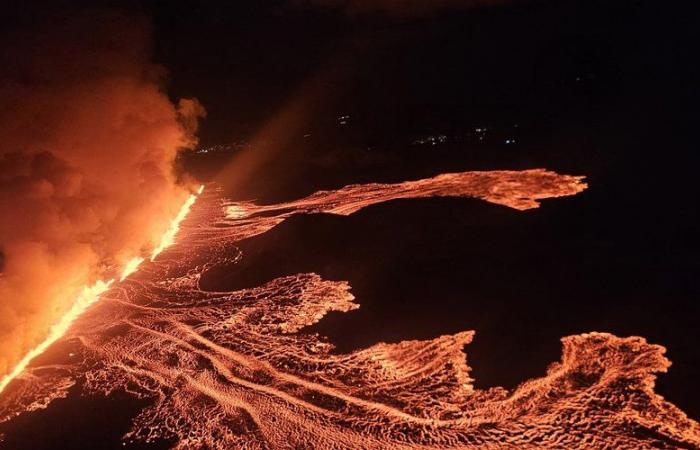the essential
The volcano Sundhnjukagigar erupted during the night of Wednesday 20 to Thursday 21 November 2024 on the Reykjanes peninsula, in southwest Iceland. This is the seventh eruption in the region since December 2023, according to the weather service.
At around 11 p.m. this Wednesday, November 20, 2024, the Icelandic Meteorological Office (IMO) noted increased seismic activity on the Reykjanes peninsula, in southwest Iceland. A quarter of an hour later, the volcano Sundhnjukagigar erupted. Broadcast live, images show lava gushing from a long fissure, surrounded by thick smoke.
Civil protection nevertheless triggered a state of emergency for the region, as always during an eruption near an inhabited area. Although the lava did not flow towards the neighboring fishing village of Grindavík, the latter was evacuated as a precaution. Only “around fifty houses were occupied in recent nights,” civil protection said. As for Keflavik International Airport, which is located on the Reykjanes Peninsula and happens to be the largest in Iceland, its air traffic has not been affected, according to operator Isavia.
Eruption less violent than in August
Interviewed by the public broadcaster, Benedikt Ófeigsson, a specialist in deformation movements of the earth's crust at the Icelandic Meteorological Office, indicated that “the flow is around 1,200 to 1,300 cubic meters per second.” As for the length of the crack, it “is estimated at 2.5 km”, indicated the Icelandic Meteorological Office (IMO) in a press release, specifying: “Given the current situation, this eruption is smaller than the previous one”, which took place at the end of August. “The outpourings are lower and the lava is not flowing as quickly.”
Grindavík, ville fantôme
This is the seventh eruption in the region of this fishing village since December 2023, the last one dating from the end of August 2024. A year ago, Grindavík was occupied by 4,000 inhabitants. When the first volcanic eruption occurred in December 2023, everyone was evacuated. Since then, few residents have returned to their homes, the majority of which were sold to the state. A second eruption occurred in January 2024, during which three houses were engulfed in flames.
Iceland is home to 33 active volcanic systems, as it is located on the Mid-Atlantic Ridge. This fault in the ocean floor separates the Eurasian and North American tectonic plates, causing earthquakes and eruptions.






